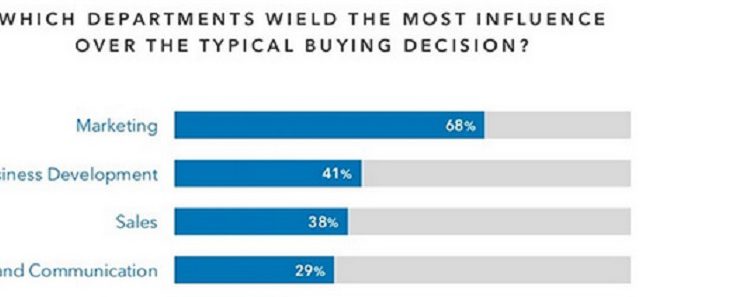Earlier this year, LinkedIn set out to determine which departments wield the most influence over B2B buyers across a number of different sectors. Their findings show that overall, marketing has 30% more sway than sales in a typical B2B buying decision and that marketing has 27% more sway than business development.
Even though marketers have the most pull as they add the most value, we have found that in many cases, marketing’s influence on LinkedIn is minimal. They’re more interested in pushing out content and filling the top of their funnel than using their influence to actually drive revenues.
What’s Wrong with the Role Marketers Play on LinkedIn Now….
My recent article, “CMOs Are Failing to Go Beyond Brand Awareness” which analyzes the actions the CMOs at Xerox, Lithium, G 2Crowd, Wiley, and XOJet are proof that when it comes to social media, marketers focus is on the top of the funnel. They’re focused on “sponsored status updates,” “sponsored inmails” and company page posts. But if those leads get stuck on the top because they don’t have the value-added relationships that buyers want, what good are those leads? How can you demonstrate a clear social media ROI with brand awareness metrics? You can’t!
Marketing is relying on sales to make the relationships. Marketing may provide sales with content to use – but no context. And, they don’t provide sales with a strategy on how to use the content to nurture relationships and transition buyers. This is why at least 70% of content is not used by sales and why enterprise buyers reported to Forrester that 61% of sales professionals add no value to the process.
What Marketing’s Sales Enablement Role Should Look Like on LinkedIn
1) Marketing as a Sales Enabler on LinkedIn Goes Beyond Top-of-the-Funnel Awareness and Lead Generation. They focus on the complete awareness to revenue customer lifecycle that includes a set of psychological transitions where customers become aware of, evaluate, like, advocate and invest in a specific product or service. They go beyond the awareness tactics that social media and digital marketing executives take- and they meld traditional marketing with LinkedIn so companies can increase the percentages of transitions as well as increase the speed at which they transition.
Marketers need to take a pipeline marketing approach, make decisions based on revenue generation instead of leads and optimize all aspects of the LinkedIn marketing program to widen every stage of the funnel to deliver more MQL’s, more SQL’s, more sales opportunities, and more deals.
2) Marketing as a Sales Enabler on LinkedIn is Focused in Optimizing the ROI of the LinkedIn Selling System. LinkedIn sales enablers equip all client-facing employees with the ability to consistently and systematically have a valuable conversation with the right set of customer stakeholders at each stage of the customer’s problem-solving life cycle. Notice, I mentioned consistently and systematically – that means going beyond just supporting content. It means putting a strategy for sales and marketing to execute in alignment, track and optimize for a stronger ROI of the selling system.
3) Marketing as a Sales Enabler on LinkedIn Provides Buyer Insights – By allowing sales to see and understand the Digital Body Language of buyers, marketers can give them the knowledge they need to figure out what an individual cares about, who within an organization is engaged in a buying process, and which organizations within a salesperson’s territory are showing buying interest. By mixing LinkedIn Sales Navigator, social listening tools, and competitive intelligence solutions with effective “relationship” engagement strategies, marketing can capture these insights. They can then lay out an account based marketing strategy for using these insights to get and keep the attention of these key decision makers.
4) Marketing as a Sale Enabler on LinkedIn are Prospect-Centric and are Focused on Building and Leveraging Relationships with Key Decision Makers. Marketers who are LinkedIn sales enablers do not have a resume based profile that discusses their campaign performance. Their profile positions them as subject matter experts who communicate their business value to buyers in order to become the “social” bridge between B2B buyers and sales. They are focused on building communities of interest where they showcase thought leadership with content and discussions around specific “issues” their prospects are experiencing and “issues” related to the industries they serve. They are focused on nurturing prospects (not mass nurturing but 1-to-1 nurturing) with relevant insights and value until buyers are ready for a sales conversation and hand-off to sales.
B2B LinkedIn Sales Enablement in a Nutshell
Marketers who go beyond lead generation and focus on Sales and Marketing alignment to achieve revenue goals using LinkedIn can prove a clearer, stronger social media ROI using LinkedIn. By providing rich insights into buyers, their companies, and their territories, marketers enable sales to better prioritize their efforts. And by focusing on relationships and how to leverage them, marketers can become the social bridge between buyers and sales. They can help build familiarity between salespeople and their customers. Together, sales and marketing can improve sales effectiveness using LinkedIn. But marketing has to use its influence on LinkedIn and become more of a sales enabler – and support sales in a more meaningful way so they can close deals using the #1 b2b social media platform.
Click here to learn more about my LinkedIn leads to revenue approach.



